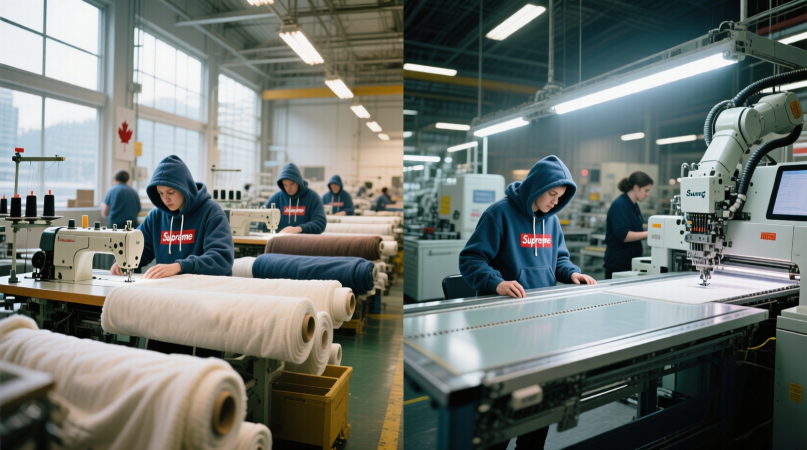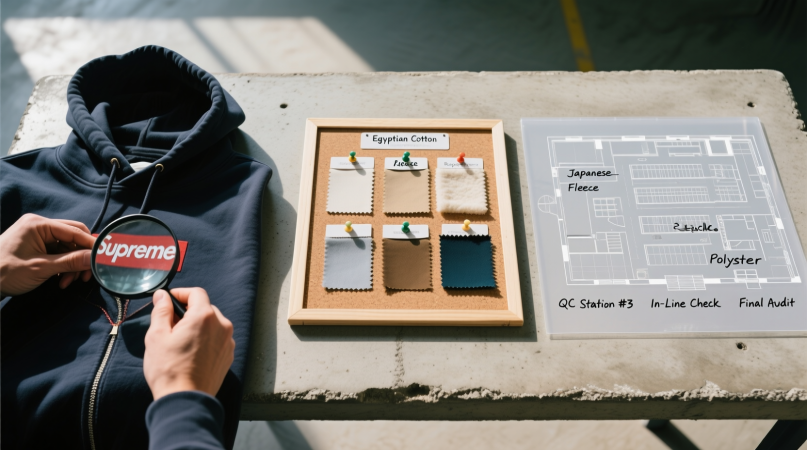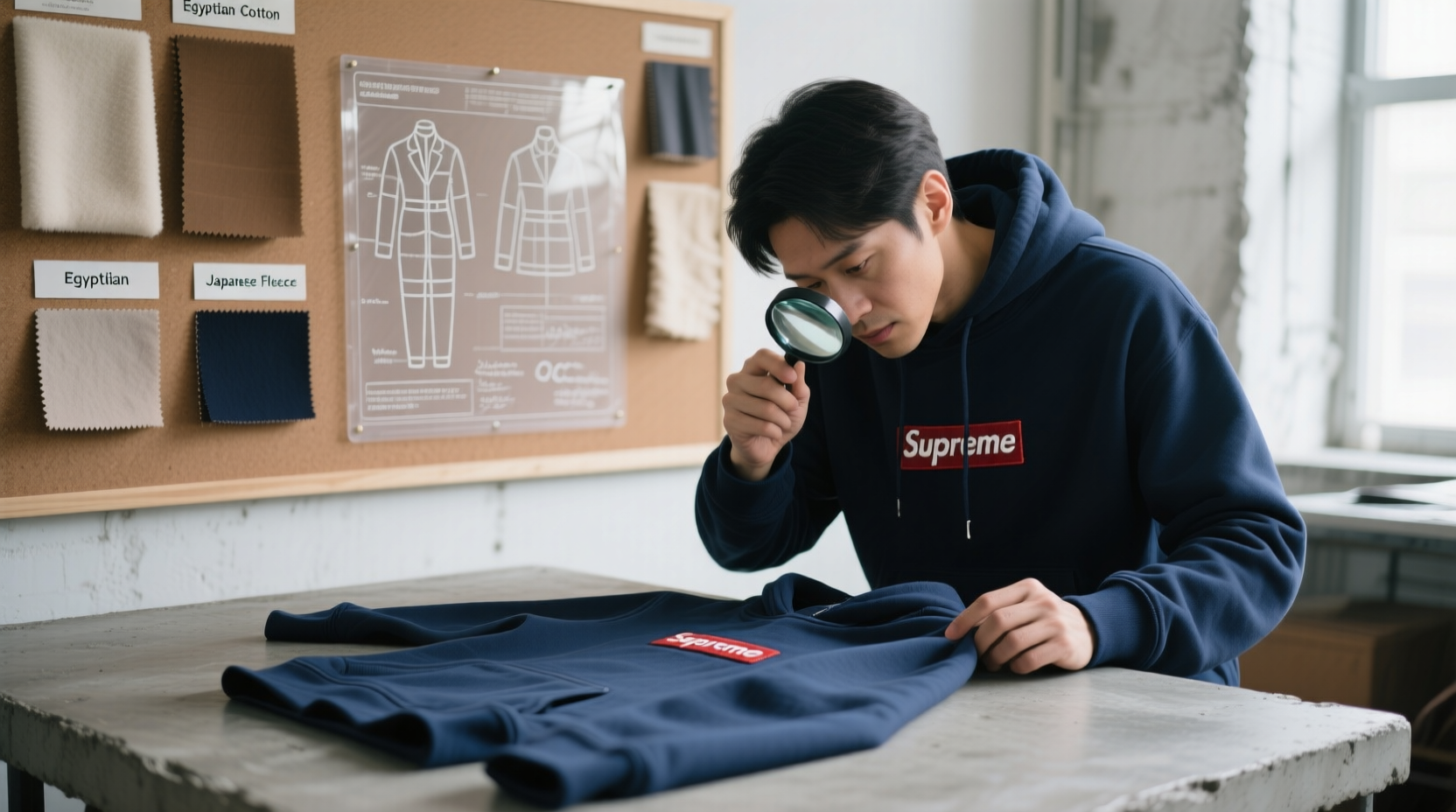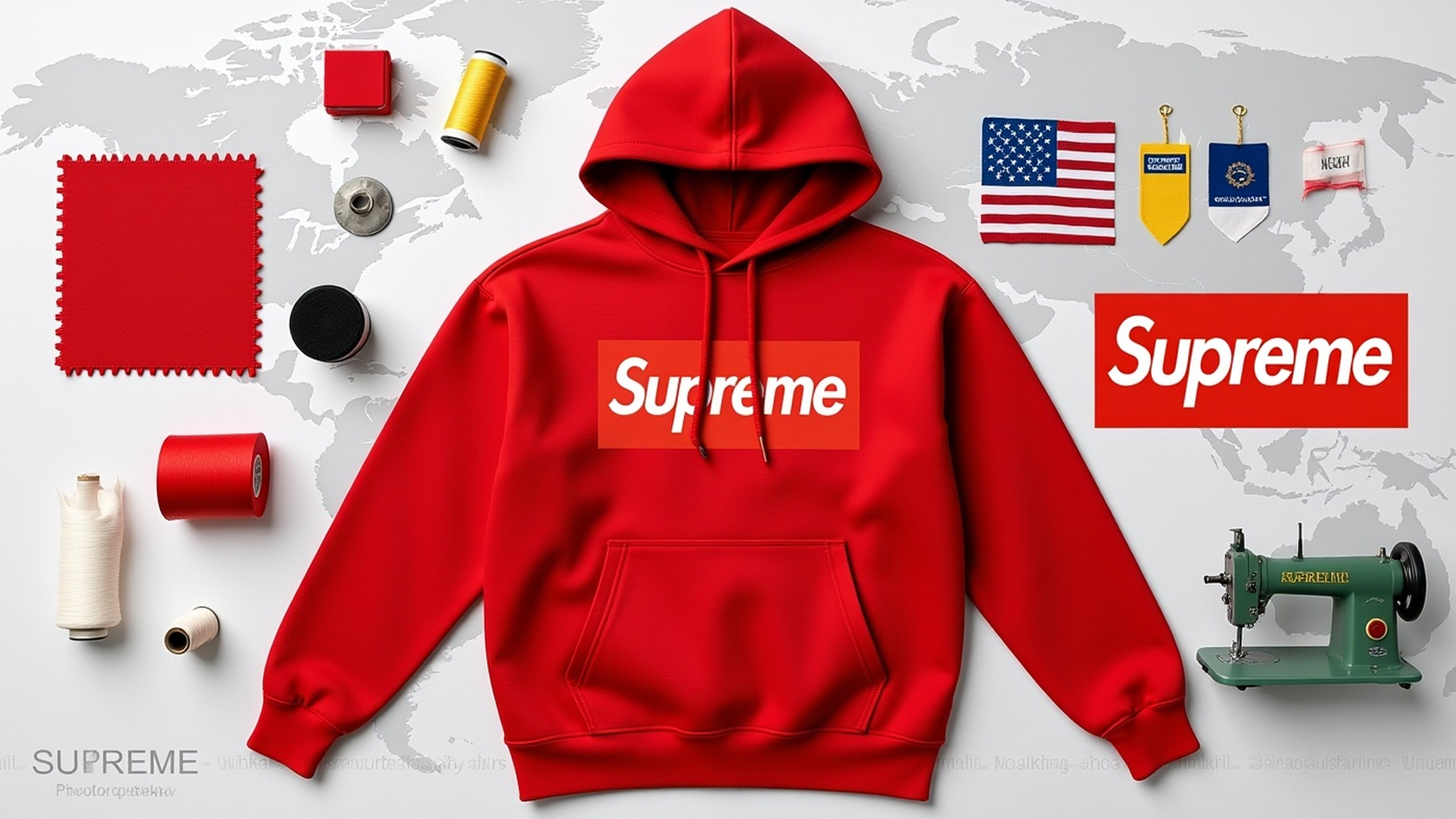Let’s be real — you didn’t click this because you care about factory locations. You clicked because you’re trying to build something that feels like Supreme. Not the resale hype, not the lines around the block. The weight of it. The way it hangs on the body. The fact that people will pay $600 for a hoodie with a red box on it.
You want to know: How do they do it?
And more importantly: Can I do it too?
Short answer: yes.
Long answer: it’s not about where they make it. It’s about how they think about making it.
I’ve spent the last decade helping brands — from garage startups to global retailers — figure out how to make apparel that doesn’t just look good, but lasts. And trust me, the brands that win aren’t the ones copying Supreme’s logo. They’re the ones copying Supreme’s discipline.
At Fexwear, we’ve worked with founders who started with nothing but a sketch on a napkin and now move thousands of units per drop. The difference between them and everyone else? They stopped asking “Where are Supreme hoodies made?” and started asking, “What does that mean for how I build my own?”
So let’s cut through the noise. No fluff. No influencer-style storytelling. Just the raw truth about where Supreme hoodies come from, why it matters, and what you can actually use from it — whether you’re launching a streetwear line or just tired of cheap gear falling apart after two washes.
Where Are Supreme Hoodies Made? The Real Answer Isn’t on the Label

You already know the surface answer: Supreme hoodies are made in Canada, the U.S., and China. But that’s like saying a Rolex is made in Switzerland — technically true, but it doesn’t tell you why it costs $10,000.
The real story isn’t geography. It’s control.
Supreme doesn’t own factories. They don’t even design every fabric from scratch. What they do own is a system — a ruthless, obsessive process that ensures every hoodie, no matter where it’s stitched, feels like theirs.
And that’s where most brands fail. They see “Made in Canada” and think, If I just make mine there, I’ll be premium. Nope. You’ll just be expensive.
Let me tell you about a client — let’s call him Jake. He came to us two years ago, obsessed with “Made in USA” as his brand’s selling point. He wanted heavyweight cotton, local production, the whole vibe. We told him: great, but only if you’re ready to pay $98 per unit and wait 12 weeks for 500 pieces.
He blinked. Then said, “Wait… can we do the same quality… but faster?”
That’s when we shifted from manufacturer to partner.
We showed him how to use a hybrid model: core styles produced in vetted Chinese facilities with the same 400 GSM fleece, YKK zippers, and double-needle stitching — but with tighter oversight than most “local” shops. We brought in a third-party inspector. We used the same fabric mill in Japan that Supreme uses for some runs. And we cut his cost in half without losing the feel.
Now? His brand’s growing faster than he expected. Not because of a label. Because of consistency.
That’s the lesson here: Supreme wins because they standardize quality, not location.
You can make a hoodie in Bangladesh and have it feel more premium than one made in Brooklyn — if you control the details.
And if you’re serious about building something real, you need to stop chasing “cool” factories and start building your own system.
Because here’s the truth no one wants to admit: “Where are Supreme hoodies made?” is a distraction.
The real question is: How do they make sure every one feels the same?
That’s what we’re going to break down.
The Three Pillars of Supreme’s Manufacturing Strategy

Supreme’s model isn’t magic. It’s methodical. They’ve built a three-legged stool:
- Manufacturing location strategy
- Material sourcing discipline
- Cost-quality balance
Knock one leg over, and the whole thing collapses.
Let’s walk through each.
Manufacturing Locations — Not “Where,” But “Why”
Supreme doesn’t pick factories based on patriotism or PR. They pick them based on purpose.
Look at that. The “premium” location (Canada) is expensive and slow. The “budget” location (China) is efficient but not low-quality.
And here’s the kicker: the hoodie from China isn’t worse. It’s just different in intent.
Supreme uses China for scale. Canada for prestige. LA for hype.
But — and this is critical — they enforce the same specs everywhere.
That means:
- Same fabric weight (usually 12–14 oz fleece)
- Same stitching density (double-needle, 8–10 SPI)
- Same zipper brand (YKK)
- Same wash standards
You can’t just say “I’ll make it in Canada” and call it premium. You have to engineer it that way.
We had a brand come to us wanting a “Supreme-style” hoodie. They assumed it was about the fabric. We said: “It’s about the construction.”
So we broke it down:
- Neck tape: Reinforced with 1” cotton ribbing
- Cuff and hem: 2×2 rib, 3cm width, locked stitching
- Pocket: Kangaroo pouch with clean interior seam
- Hood: Double-lined, drawcord with metal aglets
We didn’t change the country. We changed the details. And suddenly, their $45 hoodie felt like $80.
That’s the power of specs over slogans.
“We don’t chase ‘Made in USA.’ We chase made to standard.”
— Fexwear Production Lead, after a client demanded a factory tour in LA
If you’re serious about quality, stop outsourcing your standards. Own them.
And if you want to see how we help brands lock in their tech packs, check out our guide on turning ideas into real sportswear — it’s how we’ve helped over 200 brands avoid costly mistakes.
Material Sourcing — The Hidden Engine of Quality
Let’s talk about cotton.
Supreme doesn’t use “cotton.” They use specific cotton.
- USA Pima cotton — long-staple, soft, durable
- Egyptian Giza cotton — even longer fibers, luxurious hand feel
- Japanese fleece — often from Teijin or Unitika, brushed for warmth
And they don’t just say they use it. They prove it.
Every fabric roll is batch-tested for:
- Shrinkage (max 3% after 3 washes)
- Pilling resistance (Martindale test, 20,000+ rubs)
- Colorfastness (no bleeding, even in hot water)
This isn’t optional. It’s non-negotiable.
And here’s where most brands fall off: they pick a fabric based on feel, not function.
I had a client once — luxury streetwear, big Instagram following — who chose a “soft” fleece from a supplier. First wash? Shrank 15%. Customers went nuclear. Brand never recovered.
Moral: Feel is temporary. Performance is forever.
At Fexwear, we work with over 50 fabric options — from recycled polyester to bamboo fiber — but we don’t just offer them. We vet them.
We test every new fabric in our lab:
- Weight (GSM)
- Stretch recovery
- Moisture wicking
- Abrasion resistance
And we document it all in the tech pack.
If you’re serious about building a brand that lasts, start with your materials. Don’t just ask, “Is it soft?” Ask:
- Will it hold up after 50 wears?
- Does it maintain color?
- Can it handle sublimation printing without cracking?
For a deep dive on what fabrics actually work for performance hoodies, check out our fabric recommendations guide — it’s saved more than a few brands from disaster.
Cost vs. Quality — The Myth of “Cheap” Manufacturing
Let’s be honest: most people think “Made in China = cheap.”
It’s not.
It can be cheap. But it can also be better than domestic production — if you know what you’re doing.
Supreme’s Chinese factories aren’t sweatshops. They’re high-efficiency, tech-driven facilities with:
- Automated cutting tables
- Computerized embroidery machines
- In-line quality scanners
And they’re audited. Not just by Supreme, but by third parties like Bureau Veritas or SGS.
So why do Supreme hoodies from China cost $20–$40 to make, but sell for $300+?
Because cost to produce ≠ value to customer.
The value is in:
- The brand
- The drop model
- The scarcity
- The perception of quality
And here’s the brutal truth: you can have all the quality in the world, but if no one believes it, it doesn’t matter.
That’s why Supreme doesn’t just make hoodies. They curate them.
Limited runs. No pre-orders. No discounts.
And that’s why a $40 hoodie feels like $300.
So what’s the lesson for you?
You don’t need to spend $100 per unit to make something valuable.
You need to:
- Control your quality
- Tell your story
- Build scarcity
- Deliver consistency
We helped a UK-based brand do this last year. They launched with 300 hoodies — same specs as Supreme, same Japanese fleece, same double-needle stitching. But made in China, not Canada.
They priced it at £120. Sold out in 11 minutes.
Not because of the label. Because of the promise.
And that’s the game.
How to Build Your Own “Supreme-Level” Quality (Without the Hype)

You don’t need Supreme’s budget. You don’t need their hype. But you do need their process.
Here’s how we help brands build that.
Start with a Tech Pack — Not a Dream
You don’t start with a factory. You start with a document.
A tech pack is your blueprint. It should include:
- Flat sketches (front, back, side)
- Measurements (with tolerances)
- Fabric specs (GSM, composition, supplier)
- Stitching details (SPI, thread type)
- Trims (zippers, labels, drawcords)
- Packaging (polybag, hangtag, care label)
No ambiguity. No “kind of like this.”
We had a client send us a Pinterest board and say, “Make it like this.” We said: “That’s not a design. That’s a mood.”
So we built the tech pack from scratch. Took three weeks. Cost them $1,200.
Now? They’ve produced 5,000 units without a single quality issue.
Worth it? Absolutely.
If you’re ready to turn your idea into a real product, we’ve got a free consultation to help you get started — no pitch, just real talk.
Choose the Right Factory — Not the “Best” One
There’s no “best” factory. Only the right one for your needs.
Ask yourself:
- Do I need speed? → Look at China or Vietnam
- Do I need small batches? → Consider LA or Turkey
- Do I need premium feel? → Canada or Portugal
But — and this is critical — visit the factory or work with someone who has.
We’ve walked the floors of every facility we partner with. We’ve seen the QC stations. We’ve tested the water in the dye vats.
Because trust is earned. Not assumed.
And if you’re working with a manufacturer who won’t let you tour, run.
Enforce Quality — Every Single Time
Supreme uses a three-tier inspection system:
- Pre-production: Fabric and trim approval
- In-line: Random checks during sewing
- Final audit: 100% inspection before shipping
We do the same.
And we go further: we film the production process. Send clips to clients. Flag issues before they become batches.
Because one bad run can kill a brand.
So don’t skip QC. Don’t assume. Verify.
What Your Brand Can Actually Learn From Supreme
Let’s cut the bullshit.
You’re not going to be Supreme.
And that’s fine.
Because Supreme isn’t winning because of their factories. They’re winning because they own the process.
So here’s what you can steal:
- Standardize your specs — Every hoodie, every color, every batch. Same fabric, same stitching, same zipper.
- Control your story — “Made in China” isn’t bad. “Made poorly” is. Tell the truth about your process.
- Build scarcity — Don’t flood the market. Launch small. Sell out. Repeat.
- Invest in the details — Neck tape, stitch density, wash testing. These are your silent salespeople.
And if you’re wondering where to start, just contact us. No sales call. Just a conversation about what you’re building and how we can help.
FAQs
1. Are Supreme hoodies made in China?
Yes. A lot of them. But not cheaply. They use high-end, audited factories in Guangdong.
2. Why are Supreme hoodies so expensive?
The cost to make one is $20–$100. The rest is brand, hype, and scarcity.
3. Is “Made in Canada” better than “Made in China”?
Not automatically. It depends on the factory, the specs, and the oversight.
4. Can I make a Supreme-quality hoodie for my brand?
Yes. With the right manufacturer, materials, and attention to detail.
5. What fabric does Supreme use?
Heavyweight cotton fleece (12–14 oz), often ring-spun, with YKK zippers and reinforced stitching.
6. How do I avoid quality issues when manufacturing?
Use a detailed tech pack, enforce in-line QC, and never skip final inspection.
7. Should I make my hoodies in the USA?
Only if you need small batches or fast turnaround. Otherwise, you’re paying for the label, not the quality.
8. How do I start my own hoodie line?
Start with a clear design, build a tech pack, choose a reliable manufacturer, and launch small.
Call to Discussion
Look, I’m tired. It’s Friday. I’ve just come off a 14-hour production call with a client whose fabric shipment got held at customs. Again.
But I wrote this because I see too many brands chasing shadows.
You don’t need Supreme’s factory. You don’t need their budget.
You just need to care — really care — about the details.
Because in the end, people don’t buy “Made in Canada.”
They buy trust.
And that’s something you can build, no matter where you sew the first stitch.
Agree, disagree, or got a wild story? Let’s hear it.

